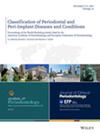Bmi-1 alleviates alveolar bone resorption through the regulation of autophagy
Abstract
Background
B-cell‑specific Moloney MLV insertion site-1(Bmi-1)is a crucial osteopenic target molecule. The aim of this study is to explore the effects of Bmi-1 on alveolar bone resorption and the underlying mechanisms in vitro and vivo.
Methods
A Bmi-1-knockout (Bmi-1−/−) mouse model was used to investigate the effect of Bmi-1 on alveolar bone metabolism, with micro-computed tomography imaging, histology, and immunohistochemistry staining. Furthermore, we utilized a ligature-induced experimental periodontitis model to examine the impact of Bmi-1-knockdown (Bmi-1±) on inflammatory alveolar bone resorption. Finally, we stimulated human periodontal ligament stem cells (hPDLSCs) with lipopolysaccharide (LPS) to explore the potential mechanism of Bmi-1 overexpression in the process of osteogenesis.
Results
Compared with wild-type mice, Bmi-1−/− mice demonstrated more alveolar bone resorption by inhibiting osteogenesis, which was characterized by decreases in Runt-related transcription factor 2 and type 1 collagen formation. In addition, Bmi-1−/− mice had lower levels of autophagy markers such as Parkin and LC3, but higher levels of inflammation-related factors such as interleukin (IL)-6 and IL-1β in periodontal tissues. In addition, Bmi-1-knockdown aggravated ligature-induced alveolar bone loss. Under in vitro inflammatory conditions, Bmi-1 overexpression stimulated osteoblast differentiation and inhibited the production of inflammatory factors, as well as the autophagy and apoptosis in hPDLSCs stimulated with LPS. When 3-methyladenine (3-MA), an autophagy inhibitor, was added, the osteogenic effect of Bmi-1 was further enhanced.
Conclusions
Bmi-1 alleviates alveolar bone resorption by regulating autophagy, indicating that it could be a potential target for periodontitis prevention and treatment.
Plain Language Summary
Periodontitis is a chronic inflammatory disease, which leads to progressive destruction of periodontal tissues, manifested as periodontal pocket formation, loss of periodontal attachment and alveolar bone resorption. Currently, there is a lack of effective treatments to regenerate damaged periodontal tissues. Therefore, it is of great clinical significance to explore new mechanisms of periodontitis and effective intervention targets. B-cell‑specific Moloney MLV insertion site-1 (Bmi-1) is involved in the regulation of the cell cycle, DNA damage repair, autophagy, bone metabolism, tumor, and other physiopathological processes. Autophagy, as an important mechanism of intracellular self-regulation, plays an indispensable role in the destruction and repair of periodontal tissues. The aim of this study was to investigate the role of Bmi-1 on periodontal tissues and its intrinsic mechanism. The results revealed that Bmi-1 regulates autophagy to protect periodontal tissues, suggesting that it may be a potential target for the prevention and treatment of periodontitis.

 求助内容:
求助内容: 应助结果提醒方式:
应助结果提醒方式:


